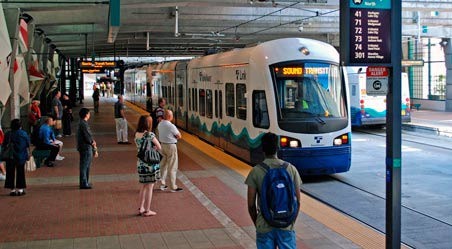Sound Transit Board leaders and regional transit supporters gathered at a news conference on Wednesday to announce the agency will move forward with sending a Sound Transit 3 ballot measure to regional voters in November 2016.
The measure can move forward following Wednesday’s adoption by the Legislature of a transportation package with the full ST3 revenue authority requested by the Sound Transit Board and supported by Gov. Jay Inslee.
“Today, as chair of the Sound Transit Board, I ask my colleagues for their support to put Sound Transit 3 on the ballot in November of 2016. We should create a ballot measure to extend light rail to Everett, Redmond, Tacoma, West Seattle, Ballard, and many communities between, to link even more destinations with bus rapid transit, and to fully integrate regional and local transit service for maximum impact,” said Sound Transit Board Chair Dow Constantine in a media release. “Thanks to the tireless work of many state legislators and my board colleagues, the Puget Sound region now has the tools to build the transportation system we need for the millions of us who are here now, and the millions more to come.”
Work by the board to shape the ballot measure will continue over the next year. One week remains in an early opportunity for the public to help shape Sound Transit 3 by taking an online survey through July 8.
“We’re grateful that the governor and Legislature came together to provide funding authority to finish our region’s longstanding vision of a high-capacity transit spine from Tacoma to Everett and downtown Redmond, with major expansions in Seattle,” said Sound Transit Board Vice Chair and Tacoma Mayor Marilyn Strickland. “We will build on that momentum by working with communities across our region to shape a measure for voters that includes the top priorities in each area.”
“The Puget Sound region is not a collection of independent cities but a single dynamic center of people and jobs. Our mobility, prosperity and environment depend on working together to create effective options to connect our growing population,” said Sound Transit Board Vice Chair and Everett City Councilmember Paul Roberts. “Everyone in our region, from transit riders to drivers to freight movers, will benefit from expanding mass transit.”
ST3 will expand congestion-free light rail farther and deeper into King, Snohomish and Pierce counties. The areas Sound Transit serves are home to more than 40 percent of Washington’s residents, 70 percent of its economic activity and 97 percent of its traffic congestion. By 2040 the area’s population is set to grow by one million people, equivalent to the current populations of Seattle, Everett and Tacoma combined.
Expanding high-capacity transit services is the best way to dramatically expand the capacity of the region’s most congested corridors and to channel growth around vibrant transit hubs where people will rely less on cars and move easily between trains and buses. A light rail line can move up to 12,000 people per hour in each direction, while a congested freeway lane occupying the same space moves as few as 700 cars.
The Sound Transit Board is seeking input on which projects should be studied as final candidates for the ST3 measure. Following a series of public meetings across the region that wrapped up last week, the online survey that is available provides a way for community members to review and comment on a draft list of candidate projects released in June. Public input will help shape a final list of priority projects to be studied this fall. Results of those studies will support further narrowing by the board to shape the draft ST3 measure for public input early next year before adopting a final measure in June for a 2016 vote.
Last year the Sound Transit Board asked the Legislature and governor for sufficient funding authority for a major region-wide ballot measure. The request was scaled to assume funding for longtime priorities including but not limited to building light rail extensions to Everett, Tacoma, downtown Redmond, Ballard and West Seattle, as well as bus rapid transit on I-405 and improving ST Express bus and Sounder commuter rail services and facilities. With the adoption of SB 5987 Sound Transit’s additional funding authority includes:
• Property tax of up to 25 cents for each $1,000 of assessed valuation ($75 annually for a $300,000 house). A property tax was identified as a way to establish a more progressive revenue source for regional transit investments that reduces reliance on the sales tax.
• Sales tax of up to an additional 0.5 percent (50 cents on a $100 purchase).
• Motor vehicle excise tax (MVET) of up to 0.8 percent of vehicle value ($80 annually on a $10,000 vehicle).
Over the past 14 years Sound Transit has developed a strong track record delivering mass transit investments. The University Link light rail extension, with new stations on Seattle’s Capitol Hill and at Husky Stadium, is on track to open in early 2016, six to nine months early and approximately $150 million under budget. In 2016 Sound Transit is also on schedule for an early opening of an extension of Link one stop further south from the airport, to Angle Lake.
In 2021 light rail service is scheduled to open to Northgate. By 2023 Sound Transit is on track to extend service further north to Lynnwood, south to Kent/Des Moines and east to Redmond’s Overlake area. The extensions are expected to increase overall weekday ridership to more than 350,000 by 2030.
For an online survey to help shape the ballot measure, go to soundtransit3.org through July 8.
Talk to us
Please share your story tips by emailing editor@kentreporter.com.
To share your opinion for publication, submit a letter through our website https://www.kentreporter.com/submit-letter/. Include your name, address and daytime phone number. (We’ll only publish your name and hometown.) Please keep letters to 300 words or less.

